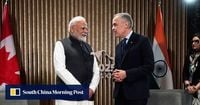After a period of frosty relations and diplomatic upheaval, Canada and India have announced a major step forward: the two countries will begin negotiations on a new free trade agreement. The announcement, made on November 24, 2025, by Canadian Prime Minister Mark Carney, comes as both nations seek to prioritize economic cooperation despite unresolved political tensions that have simmered for years.
The breakthrough followed a meeting between Carney and Indian Prime Minister Narendra Modi on the sidelines of the G20 summit in South Africa. According to a statement from Carney’s office, the leaders agreed to launch talks on what they described as an “ambitious” trade deal, with the goal of doubling two-way trade to $70 billion by 2030. This target represents a significant leap from the roughly $12.3 billion in goods and services exchanged between the two countries in 2023, as reported by multiple sources including the South China Morning Post and the Associated Press.
The move signals a thaw in relations that had been deeply strained since 2023, when then-Prime Minister Justin Trudeau publicly accused India of involvement in the assassination of Hardeep Singh Nijjar, a Canadian citizen and prominent figure in the Khalistan separatist movement. Nijjar’s murder in Vancouver, and Ottawa’s subsequent allegations of Indian involvement, sparked a diplomatic rift that disrupted consular and trade services and cast a long shadow over bilateral ties. India has consistently denied the allegations, maintaining that it had no role in the killing.
Despite this unresolved controversy, both governments now appear willing to put economic interests above political disputes—at least for the time being. Analysts cited by the South China Morning Post suggest that the resumption of trade talks underscores a pragmatic shift: “The resumption of negotiations underscores both countries’ aim to prioritise economic ties over a resolution to a lingering political issue, even as the underlying tensions over Sikh separatism remain unresolved.”
Carney himself seemed to echo this sentiment in his official remarks. “We agreed to launch talks on an ambitious trade deal that aims to double two-way trade to $70 billion by 2030,” he said, highlighting the economic opportunity for both nations. Carney also revealed that he had accepted Modi’s invitation to visit India early next year, a gesture that some observers see as a further signal of rapprochement.
Canada’s renewed interest in diversifying its trade partnerships comes at a time of significant economic pressure. Since taking office in March, Carney has repeatedly emphasized the need to reduce Canada’s reliance on the United States, which has imposed punishing tariffs on key Canadian sectors in recent years. For both Canada and India, deeper economic engagement offers a way to hedge against external shocks and tap into new markets—especially as global trade dynamics shift in the wake of geopolitical tensions and protectionist policies.
Yet, the backdrop to these talks remains fraught with historical and political complexity. Canada is home to the largest Sikh community outside India, including activists for the Khalistan separatist movement. The Khalistan campaign, which dates back to India’s independence in 1947, has been linked to some of the most traumatic episodes in modern Indian history, including the assassination of a prime minister and the bombing of a passenger jet. These events have left deep scars and continue to influence Indian domestic and foreign policy, particularly in dealings with Western countries that host sizable Sikh diasporas.
The 2023 assassination of Nijjar, a naturalized Canadian citizen and vocal Khalistan campaigner, brought these tensions to a head. Ottawa’s accusation that New Delhi orchestrated the killing—and its claims that other Sikh activists in Canada were also being targeted—sparked outrage in India and led to a near-complete breakdown in bilateral relations. Consular services were disrupted, trade discussions stalled, and the diplomatic standoff threatened to spill over into other areas of cooperation.
India, for its part, has consistently rejected the accusations, characterizing them as unfounded and politically motivated. The Indian government has argued that Canada’s tolerance of separatist activism on its soil undermines Indian sovereignty and security, a point of contention that has complicated efforts at rapprochement.
Despite these challenges, the economic logic of renewed engagement appears compelling for both sides. As the South China Morning Post notes, “the resumption of trade talks reflects both countries’ desire to prioritize economic ties over unresolved political issues.” With two-way trade currently valued at just over $12 billion, the potential for growth is significant—especially if both governments can maintain a delicate balance between economic pragmatism and political sensitivities.
The stakes are high. For Canada, expanding trade with India offers a chance to diversify its export markets and reduce vulnerability to U.S. tariffs and policy shifts. For India, closer economic ties with Canada could mean access to new technology, investment, and a broader range of goods and services—benefits that could help fuel its own ambitious development goals.
Still, the underlying issues have not disappeared. The Khalistan movement remains a deeply divisive topic, and the legacy of past violence continues to shape perceptions on both sides. The challenge for negotiators will be to keep economic talks on track without allowing unresolved political disputes to derail progress—a task that will require deft diplomacy and a willingness to engage in difficult conversations.
Looking ahead, Carney’s planned visit to India early next year may offer an opportunity to build on the momentum generated by the G20 summit. Both leaders have signaled their commitment to pursuing an “ambitious” agreement, but the path forward is likely to be anything but straightforward. As history has shown, the intersection of economics and politics can be a tricky one to navigate—especially when national identities and deeply held grievances are at stake.
For now, however, the announcement of renewed trade talks marks a rare moment of optimism in a relationship that has been defined by both cooperation and conflict. Whether this new chapter will lead to lasting change remains to be seen, but for Canadians and Indians alike, the prospect of deeper economic ties offers at least a glimmer of hope in uncertain times.
